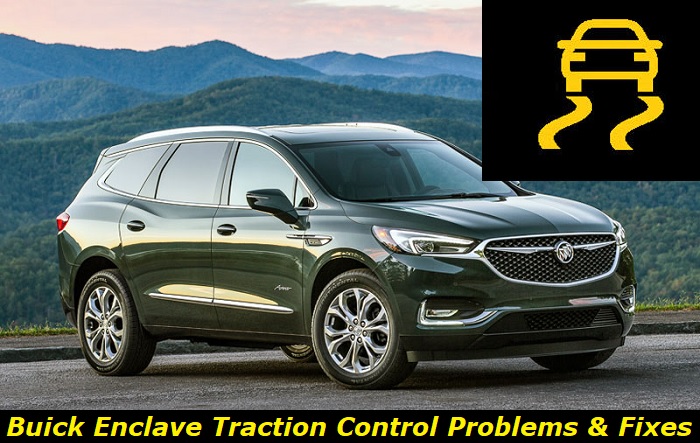If you own a Buick Enclave, you may have encountered traction control problems and error messages. Traction control helps keep your vehicle stable and secure on slippery surfaces, so it's important to be aware of any issues that might arise with this feature.
Service traction control message highlights
- Common reasons:hundreds of reasons are possible
- How to fix:read the codes to narrow down the possible problems
- Possible consequences:limp mode, stalling, harsh engine work
- Priority level:Medium
- Can you drive?Carefully
- DIY repair:Possible
- Repair price range:$150-$1,000

Traction control problems can come from many factors but the most common of them in the case of the Buick Enclave are the following:
1. Wheel Speed Sensor and/or ABS Sensor Failure
The Traction Control System (TCS) and Anti-Lock Braking System (ABS) have differing functions in a vehicle. TCS prevents wheel spin when the vehicle is accelerating while ABS stops the wheel from spinning when it is braking. However, these are paired to offer better stability and grip on the auto while it's being driven. Therefore, there are instances wherein a malfunctioning ABS sensor can activate TCS warnings, too.
The common cause of the problem in Buick Enclave is a faulty wheel speed sensor and/or ABS sensor. The wheel speed sensor measures how fast each wheel is spinning, while the ABS sensor monitors the rotational speed of each wheel to ensure that all four are turning at the same rate. When one or both of these sensors fail, traction control problems can ensue as the TCS will not be able to accurately know when it needs to intervene.
To diagnose this problem, it's important to first recognize any symptoms such as activation of warning lights on the dashboard, reduced power output from the vehicle engine, and wheel skidding when you're taking sharp turns or changing lanes quickly.
Next, do a visual check-up of the sensor connections to see if they are in proper working order. If not, replace them as necessary. Finally, testing with a scan tool and a manual wheel speed test can be done to determine if the TCS is functional or has any other internal issues.
To solve this, the wheel speed sensors and/or ABS sensors should be replaced with new original parts. It's important to note that both need to be replaced at the same time in most cases so all four wheels will move uniformly when driving on uneven surfaces or during hard braking conditions.
These components should also be calibrated if necessary upon installation of new parts. With all these steps taken, it should restore proper functionality for the traction control system in your Buick Enclave.
It's also important to be aware of the fact that any further TCS issues may indicate a larger problem such as a broken/detached ABS valve, faulty hydraulic modulator assembly, or damaged wiring and connectors. In these cases, further diagnosis should be undertaken to identify the root cause before attempting repairs or replacements. This can avoid unnecessary expenses or even more serious damage down the line.
Understanding the connection between the wheel speed sensor and ABS failure and traction control problems in the Buick Enclave is essential to resolving any issues. Proper diagnosis should be followed by the replacement of faulty parts with calibrated ones for optimal performance. Furthermore, be aware that further investigation may need to take place if more serious underlying problems are present.
2. Wiring Issues
One of the common causes of traction control-related warnings in the Buick Enclave is wiring issues. This can be caused by a variety of factors, such as poor connections, corrosion, or frayed wires. To diagnose this issue, it's important to first recognize any symptoms that may be present.
These could include pulsing during acceleration, illuminated warning lights on the dashboard, and a general lack of power from your vehicle under certain conditions. Once these signs have been identified, it's time to do a visual inspection of any visible wiring components near the traction control system, which specifically involves looking for rust or signs of wear and tear.
If the mentioned issues are found during the examination, then it's important to take further steps before making any replacements. This can be done using a multimeter to check the electrical current in each of these components and locate any broken wires or disconnected connections.
If it's determined that the wiring is damaged, then it's necessary to replace any corroded wires or frayed insulation before attempting to reset the traction control system. In some cases, cleaning out dirty terminals may also help resolve the problem if corrosion was found during the inspection. Replacing faulty relays or connectors with updated parts may also be necessary if they are not functioning correctly due to wear and tear or age.
Ultimately, only after all wiring issues have been resolved should one attempt to reset the traction control system-making sure to refer to your vehicle's user manual for more specific instructions on this process.
If the wiring issue causing traction control problems in the Buick Enclave is not addressed, then it can lead to even more serious issues such as a lack of power and decreased fuel efficiency. Therefore, it's important to properly diagnose any potential wiring issues before attempting to reset the traction control system.
By taking the time to do visual inspections and using a multimeter when necessary, you can accurately identify any underlying wiring problems which will help prevent further damage down the line. Eventually, correct diagnosis and repair of wiring issues related to traction control problems will help ensure your vehicle runs smoothly and safely.
3. The Battery is Drained and Not Charging
When it comes to traction control problems in the Buick Enclave, a drained or not charging battery is one of the most common causes. The first step to evaluate this issue is to look for symptoms such as the vehicle struggling to start and/or slow engine cranking; dashboard warning lights; headlight dimming when idling; and other electrical issues related to low voltage.
After that, manual checks can be done by verifying that all electrical connections are tight, inspecting fuses and relays, and measuring the system's battery voltage with a multimeter. If any of these steps indicate an irregularity with the Buick Enclave's battery, then further testing should be conducted using tools like a load tester or hydrometer.
If it is determined that the battery has failed, then the best solution to resolve traction control issues in the Buick Enclave would be to replace it. If the issue lies elsewhere, diagnostics should be done on other components such as the starter motor, alternator, and voltage regulator. In some cases, a combination of repairs will need to be done in order for the owner to get their car back up and running properly.
The most important thing is that any repair done is correctly specified and installed in order for the traction control system of the Buick Enclave to function reliably again.
4. Blown Fuse
A blown fuse can cause traction control problems in the Buick Enclave because it disrupts the power supply to certain components of its electrical system. This prevents the vehicle from accessing data and/or engaging in operations that would otherwise maintain good traction, such as applying brakes or activating antilock systems.
To confirm whether a blown fuse is causing your traction control issue, you should check all fuses associated with the electrical system. If one appears to be defective, replace it with a new fuse of the same rating and type as the original one. Doing so will restore power to any affected components and should resolve the traction control issue.
5. Control Module Failure
The Buick Enclave's traction control system issue is often caused by the failure of the associated control module, which is responsible for monitoring and controlling multiple vehicle functions. It can be tricky to diagnose since there are several common causes and symptoms linked with this problem. To accurately evaluate why the control module may have failed, it's important to do visual checks, monitor for certain symptoms, and test the components using diagnostic tools.
When analyzing the issue, an experienced technician should begin by inspecting all wiring connections to ensure they are secure. They will also look at any relevant fuse boxes as well as sensors connected to the control module that might be malfunctioning or disconnected completely.
If the issue is related to the control module itself, a technician can test it with an oscilloscope or other testing device. If all tests come back negative, then the control module may need to be replaced in order for the traction control system to function properly again.
It's also important to note that if any of the components connected to the control module are malfunctioning or disconnected, replacing the faulty part may resolve the problem even without having to replace the entire module itself. In most instances, the issue may only be limited to a software glitch in the associated module or the engine control unit (ECU), which can be easily fixed via reflashing.
In either case, it's best for a qualified technician to diagnose and repair these issues as they have specialized knowledge and experience that allows them to accurately pinpoint and solve problems quickly.
Conclusion
These are the top 5 factors triggering traction control problems in the Buick Enclave. There may also be others that may directly or indirectly contribute to the cause. Nevertheless, make sure that you are always aided by a professional mechanic or technician so you can arrive at the best possible solution to the problem that your car is experiencing.
About the authors
The CarAraC research team is composed of seasoned auto mechanics and automotive industry professionals, including individuals with advanced degrees and certifications in their field. Our team members boast prestigious credentials, reflecting their extensive knowledge and skills. These qualifications include: IMI: Institute of the Motor Industry, ASE-Certified Master Automobile Technicians; Coventry University, Graduate of MA in Automotive Journalism; Politecnico di Torino, Italy, MS Automotive Engineering; Ss. Cyril and Methodius University in Skopje, Mechanical University in Skopje; TOC Automotive College; DHA Suffa University, Department of Mechanical Engineering






Add comment